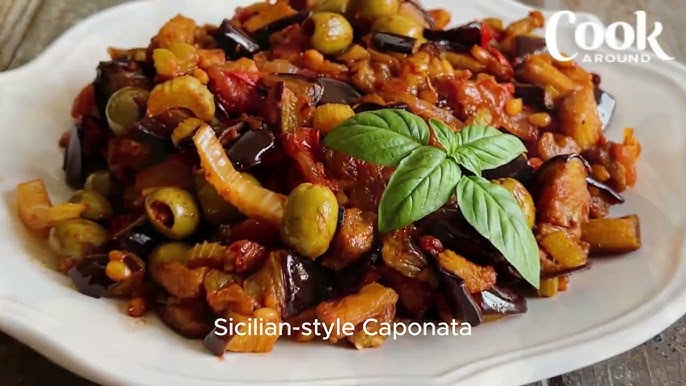Caponata Recipe: Caponata is like a warm Sicilian hug in a bowl. If you’ve never tasted this sweet-and-sour eggplant dish from Italy, you’re in for a flavorful journey.
At its core, Caponata is a cooked vegetable salad made primarily from eggplant, celery, olives, and capers, all simmered in a rich, tangy tomato-based sauce. It’s the kind of dish that gets better the longer it sits, soaking up all the flavors like a sponge.
Whether served warm, cold, or at room temperature, Caponata offers layers of taste—earthy, sweet, briny, and a little tangy.
Origin of Caponata
Caponata hails from Sicily, where culinary influences come from all over the Mediterranean. You’ll find traces of Arab, Greek, and Spanish flavor profiles all blended into this single rustic dish. Back in the day, Caponata was a peasant meal—simple, hearty, and cheap—but full of flavor. The vinegar and sugar balance is a clear sign of its Arab roots, while the use of vegetables like eggplants and tomatoes reflects the local produce Sicily is known for. Over the years, dozens of variations have developed across different towns in Sicily, making Caponata a regional specialty with endless possibilities.
Caponata vs Ratatouille
You might be thinking, “Wait, isn’t this just Italian Ratatouille?” Well, not quite. While both are veggie-heavy stews featuring eggplant, Caponata brings a punch of bold, briny flavor thanks to olives and capers and a distinctly sweet-and-sour profile from vinegar and sugar. Ratatouille, on the other hand, is softer in flavor and often oven-roasted or simmered without the sharp tang. Caponata is chunkier, bolder, and meant to be served cool or at room temp, making it ideal for antipasto platters, while Ratatouille usually takes the stage as a warm main or side dish.
Ingredients You’ll Need
Caponata is beautifully flexible—you can mix and match ingredients to fit your taste or pantry. But let’s start with the essentials.
Main Ingredients
Here’s what you’ll need for a traditional Caponata:
- Eggplants (2 large): The star of the show. Go for firm, fresh eggplants.
- Celery stalks (3-4): Sliced thin for crunch and slight bitterness.
- Onion (1 large): Finely chopped; red onions are great for sweetness.
- Tomatoes (3-4 or 1 can diced tomatoes): Fresh or canned work.
- Green olives (1/2 cup): Pitted and chopped; briny and bold.
- Capers (2 tbsp): Adds that salty, tangy bite.
- White vinegar (1/4 cup): For that iconic sweet-sour kick.
- Sugar (2 tbsp): Balances the acidity of vinegar.
- Olive oil: For frying and sautéing.
- Salt and pepper to taste.
Optional Add-ins
Want to get creative? Try these:
- Pine nuts for a nutty crunch.
- Raisins for added sweetness.
- Red bell peppers for a pop of color and flavor.
- Garlic because why not?
Ingredient Substitutes
Missing something? No stress.
- Swap white vinegar with apple cider vinegar or red wine vinegar.
- No green olives? Use black olives—just make sure they’re pitted.
- Use zucchini or mushrooms if you’re low on eggplant.
Equipment You’ll Need
You don’t need a fancy kitchen for Caponata. Just grab:
- A large skillet or sauté pan
- A sharp knife
- Cutting board
- Mixing spoon
- Bowl or container (for serving or storing)
Step-by-Step Guide to Making Traditional Caponata
Let’s get cooking! Follow these steps and you’ll be spooning this Sicilian delight onto everything.
Step 1: Prepare the Ingredients
Wash and dice your eggplants into small cubes (about ½ inch). Sprinkle them with salt and let them sit in a colander for 30 minutes—this draws out bitterness and excess moisture. Meanwhile, chop your celery, onion, tomatoes, olives, and anything else you’re adding in.
After 30 minutes, rinse and pat the eggplant dry with a paper towel. Don’t skip this—it’s key for flavor and texture!
Step 2: Fry the Eggplant
Heat a generous amount of olive oil in a skillet over medium-high heat. Fry the eggplant in batches so you don’t overcrowd the pan. Cook until golden brown and slightly crispy. Set aside on a plate lined with paper towels to drain excess oil.
Eggplant loves oil like a sponge, so don’t be shy, but also don’t drown it. The goal is tender, caramelized cubes—not soggy blobs.
Step 3: Cook the Base (Celery, Onion, Tomato)
In the same pan, add a little more oil if needed and sauté your onions until they’re soft and translucent. Toss in the celery and cook until it begins to soften—about 5 minutes. Then add your chopped tomatoes and let everything simmer until the sauce thickens and the flavors start to meld—10 to 15 minutes.
This is your Caponata’s flavor foundation. The tomato brings richness, while the onion and celery add sweetness and crunch.
Step 4: Add Capers, Olives, and Vinegar
Now comes the exciting part—layering in those bold, briny flavors. Stir in the chopped green olives and capers into the tomato mixture. Cook for a few minutes until everything is heated through and fragrant. Then, pour in the vinegar and sprinkle the sugar over the top.
Let the mixture bubble gently for 5–10 minutes. This step is what gives Caponata its signature agrodolce (sweet and sour) flavor. Taste and adjust the seasoning—add a little more sugar if it’s too sharp, or more vinegar if it needs a kick.
The vinegar-sugar combo doesn’t just enhance the flavor—it acts as a natural preservative, helping Caponata last longer and taste even better the next day.
Step 5: Combine and Simmer
Add your fried eggplant back into the pan and gently stir to combine it with the sauce. Be careful here—eggplant is delicate, and you don’t want to mash it.
Reduce the heat to low and let everything simmer together for 15–20 minutes. This step allows all the ingredients to mingle and get cozy with each other. The eggplant will soak up all that tangy-sweet sauce, and the dish will take on its signature richness.
Once done, remove the pan from heat and let it cool slightly. You can serve it warm, but it’s even better after a few hours—or even the next day—once the flavors have had time to develop fully.
Tips for the Best Caponata
Want to make Caponata that tastes like Nonna made it? Keep these pro tips in mind:
- Salt the Eggplant First: Always salt and drain the eggplant beforehand. It makes a huge difference in both texture and flavor.
- Don’t Rush It: Letting the Caponata simmer gently and rest afterward is key to unlocking deeper, more complex flavors.
- Taste as You Go: Adjust sugar and vinegar to your liking. Everyone’s sweet and sour preference is different.
- Use High-Quality Olive Oil: Since olive oil plays a big role in this dish, good quality makes a noticeable impact.
- Make It Ahead: Caponata actually improves after sitting for a day in the fridge. The flavors mellow and deepen beautifully.
How to Serve Caponata
Caponata is as versatile as it is delicious. Whether you’re hosting a dinner party or just making lunch for yourself, here are some great ways to enjoy it:
As a Side Dish
Caponata pairs wonderfully with grilled meats and fish. Its acidity cuts through fatty dishes like lamb chops or roasted pork, offering balance and brightness.
On Toast or Bruschetta
This is a classic. Load up some crusty bread or bruschetta with cold Caponata for an easy, elegant appetizer. Add a sprinkle of fresh parsley or even a crumble of feta or goat cheese for an extra twist.
With Protein
Spoon it over grilled chicken, baked tofu, or even a simple omelet. It brings color, texture, and a burst of flavor that can elevate the simplest dishes.
You can also toss it into pasta, stir it into cooked grains like farro or quinoa, or even use it as a pizza topping. Once you’ve made a batch, you’ll find yourself spooning it onto just about everything.
Storage and Make-Ahead Tips
One of Caponata’s best features? It stores like a dream.
- Fridge: Store in an airtight container in the fridge for up to 5 days. The flavors deepen over time, so it’s perfect for meal prep.
- Freezer: Yep, Caponata freezes well. Cool it completely, then freeze in a sealed container for up to 3 months. Thaw overnight in the fridge and bring to room temp before serving.
- Make Ahead: You can make it 1–2 days in advance for a party or gathering. In fact, that’s recommended—it gives it time to marinate in its own deliciousness.
Nutritional Information
Caponata isn’t just a flavor bomb—it’s actually pretty healthy too! Packed with veggies and heart-healthy olive oil, it’s a dish that brings taste and nutrition to the same table.
Here’s a general breakdown for one serving (based on a 1-cup portion):
| Nutrient | Amount (approx.) |
|---|---|
| Calories | 180–220 |
| Fat | 14–18g |
| Carbohydrates | 14–18g |
| Fiber | 4–6g |
| Protein | 2–4g |
| Sugar | 7–9g |
| Sodium | Moderate |
Most of the calories come from olive oil and eggplant, which is why portion control is key if you’re watching your intake. You can tweak the oil and sugar amounts to make it lighter, or load up on more veggies like zucchini or peppers for an extra fiber boost.
Caponata is naturally vegan and gluten-free, making it perfect for those with dietary restrictions. It’s also a great way to sneak in more vegetables if you’re trying to eat cleaner without sacrificing flavor.
Variations to Try
Once you’ve mastered the classic Caponata, it’s time to play. This dish is super versatile and can be easily adapted based on the seasons, your cravings, or what’s hanging out in your fridge.
Sweet Caponata
Lean into the sweetness by adding golden raisins or chopped dried apricots during the simmering stage. It’s a subtle but delicious twist that really complements the vinegar.
You can also roast your eggplants for a richer, deeper flavor—this adds a nice smokiness and makes the dish feel even more gourmet.
Spicy Caponata
Craving some heat? Toss in a finely chopped chili pepper or a pinch of red pepper flakes when cooking the onions. It adds a warming spice that plays well with the sweet-and-sour flavors.
You can also use spicy pickled vegetables in place of some of the celery or olives if you want to really turn up the fire.
Winter Caponata with Root Veggies
Who says Caponata is just a summer dish? In the colder months, swap out the eggplant for diced roasted squash, carrots, or even sweet potatoes. Add a few cloves of roasted garlic and you’ve got a cozier, sweeter version perfect for pairing with roasts or holiday meals.
FAQs about Caponata Recipe
What is Caponata made of?
Caponata is a Sicilian eggplant dish made with a delicious mix of eggplant (aubergine), tomatoes, onions, celery, olives, and capers, all simmered in a sweet and tangy vinegar-based sauce.
Is Caponata served hot or cold?
Traditionally, Caponata is served at room temperature or cold. Letting it sit allows the flavors to develop fully—so yes, patience pays off here.
Can I make Caponata ahead of time?
Absolutely. In fact, Caponata tastes even better the next day after chilling in the fridge overnight. It’s the perfect make-ahead appetizer or side.
How long does Caponata last in the fridge?
Stored in an airtight container, Caponata will last up to 5 days in the refrigerator. Just make sure it’s properly cooled before storing.
Is Caponata vegan?
Yes, Caponata is naturally vegan and packed with healthy vegetables. Just check your ingredients if you’re buying pre-made versions to avoid hidden animal products.
Can I freeze Caponata?
You can, but it’s not ideal. The texture of the eggplant may change when thawed. If you do freeze it, use it within 1–2 months for best flavor.
What do you eat with Caponata?
Caponata is super versatile! Enjoy it with crusty bread, as a topping for grilled fish or chicken, tossed with pasta, or even as a pizza topping.
Is Caponata the same as ratatouille?
Not quite. While both are veggie-based, Caponata is sweet-and-sour with capers and vinegar, giving it a bold Mediterranean kick. Ratatouille is more herb-forward and mellow.
Conclusion
Caponata is more than just a dish—it’s a celebration of flavors and history. With its roots in Sicilian tradition and a taste that hits all the right notes—sweet, sour, salty, and savory—it’s a recipe you’ll want to keep in your rotation forever.
Whether you serve it warm on toast, cold as a side, or mixed into pasta, this vegetable medley brings a taste of the Mediterranean to any table. And with all the room for customization, it’s one of those rare recipes that’s as fun to make as it is to eat.
So the next time you’re staring at an eggplant wondering what to do, whip up a batch of Caponata. Your tastebuds (and your dinner guests) will thank you.



